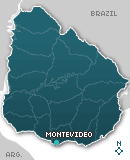Tours and Activities:
Honoring Artigas
Marcelo Sola Jorge GonzálezIn the middle of Independence Square is the mausoleum of General Jose Artigas. Inside, the most important events of the Father of the Uruguayan nation are remembered.

Jose Gervasio Artigas is considered the father of Uruguay. In the deeds of his life, the idea of federalism was always present. He worked for his people. With word and sword, he fought for the independence of Uruguay.
Today, in the middle of Independence Square in Montevideo, there is a statue that pays tribute to this man who fought with determination for a free country. Below the statue is the mausoleum where his mortal remains rest. Stairs on both sides of the bronze equestrian statue lead to the basement.
As we descended, a respectful silence filled each step that took us away from the bustle of the city. Inside, soldiers still guard the tomb of the general.

On the walls of the mausoleum the life of the hero is portrayed. However, there is not a single line of his famous quotes. The mausoleum was opened on June 19, 1977, during the dictatorship. Any phrase by Artigas could have been understood, directly or indirectly, as a speech for freedom and democracy.
We truly appreciated the place where he rests. Artigas represents to Uruguay what San Martin is for Argentina or Bernardo O'Higgins is for Chile. Artigas was an important figure in the context of Hispanic American revolutions, mainly because he was ahead of his time in terms of policy and society. There is no doubt he was an extraordinary figure recognized by historians all over the world. That is why visiting his mausoleum is as important as getting to know his own history.

His Life
He was born in Montevideo on June 19, 1764. After finishing his studies at the Franciscan School of San Bernardino, he began working on his father's farm. Years later, he earned a living by buying leather during the campaign to sell it to exporters from Montevideo. In 1797, he joined the cavalry of the regiment Blandengues as a soldier. The cavalry was created to fight cattle theft and smuggling in Uruguay and to protect the border with Brazil. In 1806, during the English invasions, he participated in the reconquest of Buenos Aires and the defense of Montevideo under Liniers’ commands.
He was in charge of carrying out the famous exodus of Uruguay in 1812 together with 16,000 people that crossed the river Uruguay to settle in Ayui near present Concordia (Entre Ríos). There he got ready to fight the royalists. At the opening of the Assembly of 1813, Uruguay chose its representatives for Congress. Inspired by Artigas, precise instructions on the federalist and revolutionary content were given to them: immediate declaration of independence, republican constitution, civil and religious liberty, equality for all the citizens, central government that respects the provincial autonomies and the establishment of the capital outside Buenos Aires.
With formal arguments, the Assembly rejected the certificates of the Uruguayan deputies. Rondeau convened another congress to choose new deputies and Artigas openly broke relations with Buenos Aires. The supreme director Gervasio Posadas declared him “traitor” and put a price of 6,000 pesos on his head.

By 1814, Artigas’ popularity spread to several of the current Argentinian provinces, affected, as Uruguay, by the free trade and only port policies promoted by Buenos Aires, which ruined the craftsmen and farmers living in the inland areas. Santa Fe, Entre Ríos, Corrientes, Misiones and Córdoba joined the Uruguayans in the League of the Free People. As the protector of the League, Artigas fought alongside the leaders of the provinces in the littoral area against the centralization of the Directory. The league created a kind of common regional market in which national producers were protected and agriculture was fostered by means of distributing land, animals and seeds. Machines, books and medicines did not pay taxes and all the trade of the above-mentioned provinces was redirected to Montevideo.
In 1815, Artigas recovered Montevideo, taken until that moment by troops from Buenos Aires. He convened a Congress of the Free People in Concepción del Uruguay on June 29, 1815. The deputies of Uruguay, Corrientes, Santa Fe, Córdoba, Entre Ríos and Misiones were there. One of the first things they did was to swear independence from Spain, to hoist the three-color flag (the same as Belgrano's flag but with a red band, symbol of federalism) and they decided to not attend the Congress of Tucumán convened by the Directory as a protest against the government of Buenos Aires that fostered a Portuguese invasion of Uruguay to end with Artigas.
While the Congress of Tucumán was being held, Artigas and his people defended the territory against a new Portuguese invasion that took Montevideo in 1817. Artigas had to march into exile to Paraguay. He lived there and died 30 years later at the age of 86 on September 23, 1850. His remains were repatriated to Uruguay in 1855.
Source: historian Felipe Pigna
© 2007-2025 Total or partial reproduction forbidden. Derechos de Autor 675244 Ley 11723


 See also:
See also: 



